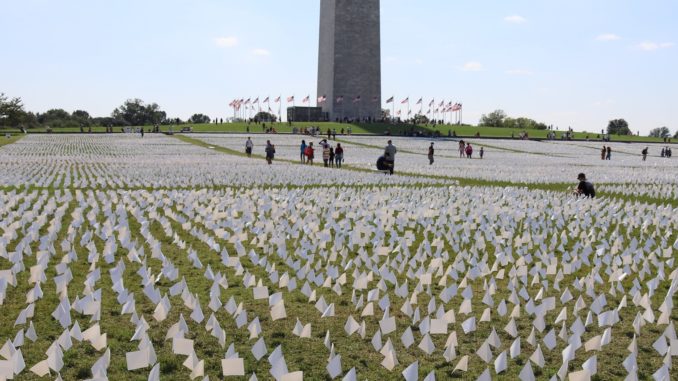
This story is produced by the award-winning journalism nonprofit Capital & Main and co-published here with permission.
In the early months of COVID-19’s spread across the U.S. last year, researchers and journalists began tracking an obvious trend: The virus was decimating communities of color, lower income neighborhoods and those living in crowded, sometimes multigenerational settings. From New York to Detroit to New Orleans and beyond, poorer residents and those already at increased health risk were becoming infected at wildly disproportionate rates.
Some of the numbers compiled since then reflect that reality. As of the most recent reporting period by the Centers for Disease Control and Prevention (CDC), Blacks in America are at twice the risk of dying from COVID as are whites, Latinos at 2.3 times the risk. In California, Blacks account for 7 percent of recorded COVID deaths, yet make up only 5 percent of the population. And Latinos, 40 percent of the state’s population, represent 47 percent of its deaths.
The figures are part of a compelling case that longstanding inequities of income, living conditions and health care have led communities of color to experience the worst of the pandemic. But a new study suggests that, if anything, those numbers are low—perhaps significantly so.
In a research letter published last week in JAMA Network Open, the study’s authors suggest that about 20 percent of excess deaths in the U.S. in 2020—that is, mortality beyond what would be expected in a normal year—“were not reflected in COVID-19 death counts.” In some areas, that undercount was severe. And it was most pronounced, the researchers found, in the parts of the country where health services are the most lacking.
“Inaccuracies in cause of death ascertainment have hidden the true scale of the pandemic and its vastly uneven impact across communities,” said Andrew Stokes, the lead author of the study and a professor at the Boston University School of Public Health (BUSPH). “We find that discrepancies between official COVID death tallies and excess mortality estimates were especially severe in areas with poor health care access and more at-home deaths.”
Those findings align almost exactly with what epidemiologists, social scientists and local health workers and clinicians have been saying for a year and a half. While COVID is unquestionably a national health emergency, it has unequally plagued families in neighborhoods where people are likely to have less access to health care or to lack health insurance altogether, and to generally live in worse conditions.
They are also the people most likely to fill the kinds of jobs—food preparation, service industry, custodial, farm labor—that were deemed “essential” as COVID spread across the U.S. and had to be performed on site. In the midst of a pandemic, they couldn’t stay home from work.
“Here in Los Angeles, the Black community remains the leader in homelessness, the leader in death, the leader in lack of access to health care,” Michelle Burton, director of the Social Change Institute at Community Health Councils, told Capital & Main in a recent interview. “In many ways, it’s about the zip code. Rates of infection, vaccine penetration, access to health care—these go along with where you live in many, many cities, including this one.”
The study, conducted by researchers at BUSPH and the University of Pennsylvania, tracked publicly available data from 2,096 counties accounting for more than 319 million U.S. residents. They found that for every 100 excess deaths that were directly attributed to COVID-19 last year, there were another 20 that weren’t counted as such—for a variety of reasons.
That proportion grew, the authors said, in counties “with lower average socioeconomic status, counties with more comorbidities (underlying health problems), and counties in the South and West.” Counties with more Black residents—already at risk for higher COVID-19 mortality—also reported a higher proportion of excess deaths that weren’t attributed to the disease.
In some cases, the authors said, these excess deaths were almost certainly caused by COVID. In others, death may have resulted from a factor related to the spread of the disease, such as severely strained medical systems that could not adequately treat those suffering from other illnesses or emergencies.
The researchers also noted that one factor in the underreporting is that poorer communities in the U.S. never received adequate COVID testing in the first place, so some people became ill and died without ever being diagnosed. In addition, Stokes’ team hypothesized that coroners or other elected officials lacking medical experience might not have recognized COVID as the cause of death—or simply might have refused to do it for political reasons.
Rural areas, where access to primary care can be severely limited, reported higher percentages of excess deaths that didn’t get attributed to COVID, the study found. Counties with higher numbers of people who died at home, rather than at a hospital or nursing home, also had more cases that were not attributed to the virus. The pattern is clear: In poorer areas, rural areas and places where healthcare was already inadequate, there’s a considerable gap between how many people are reported to have died from COVID and how many actually did.
There’s another bit of fallout from this sort of underreporting. When the phrase “COVID-19” fails to appear on a death certificate, “These populations are less likely to be able to access government support, such as funeral assistance from FEMA,” said Irma T. Elo, chair of sociology at Penn and a co-author of the study. “This is one of many examples of how COVID-19 has exacerbated existing racial and ethnic inequalities.”
As of today (Sept. 24), the CDC put the U.S. death count from COVID-19 at 680,688. Johns Hopkins University’s data tracker has the number closer to 684,000. But it’s clear that the actual COVID toll in the country is much higher—and that difference has been borne by the communities that can least afford it. As both California and the nation consider health system changes in response to the crisis, this reality demands a seat at the table.
Copyright 2021 Capital & Main




Be the first to comment